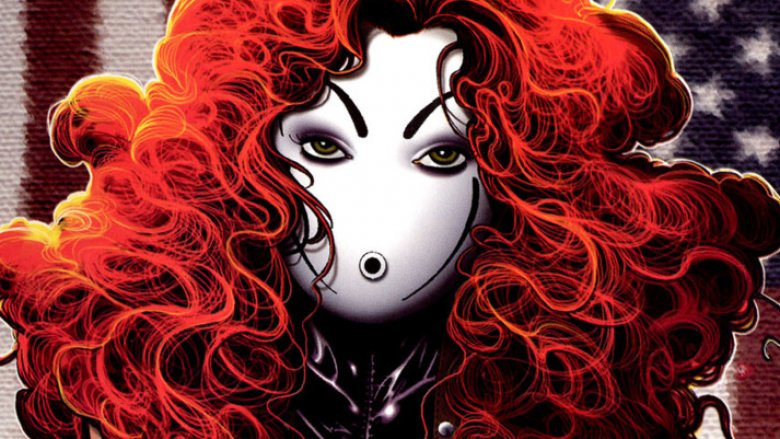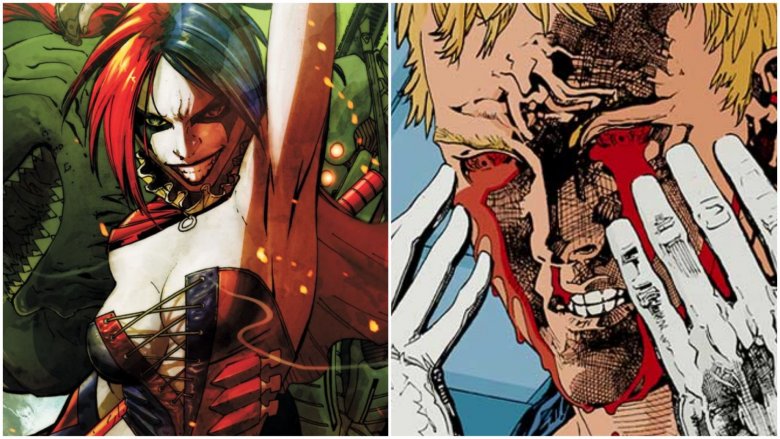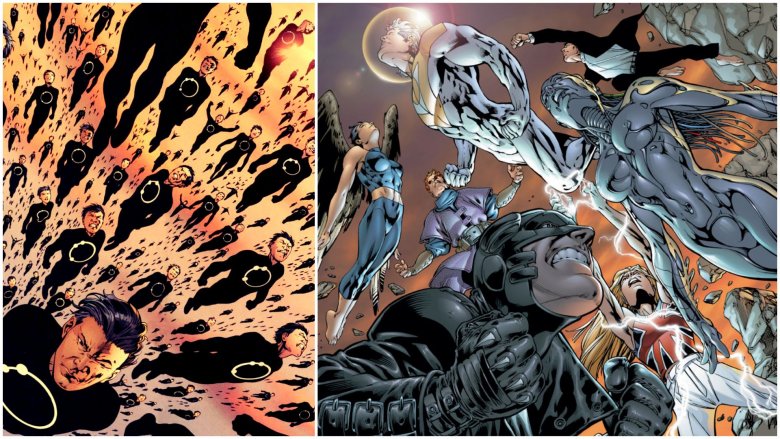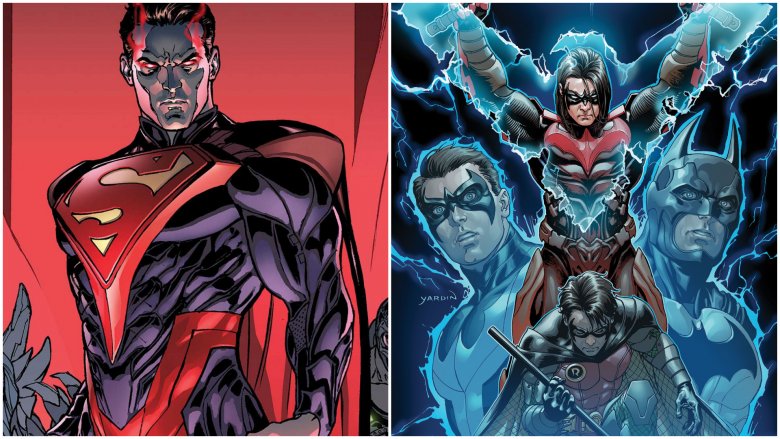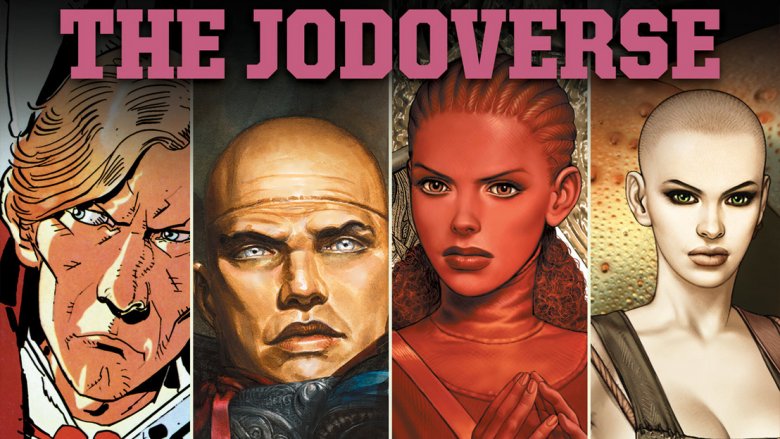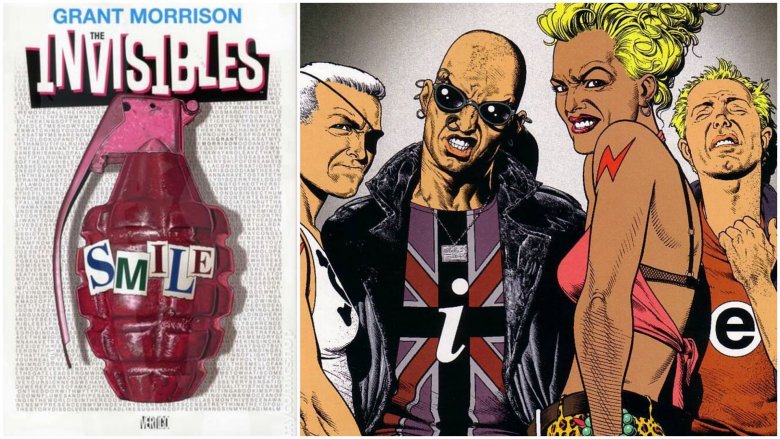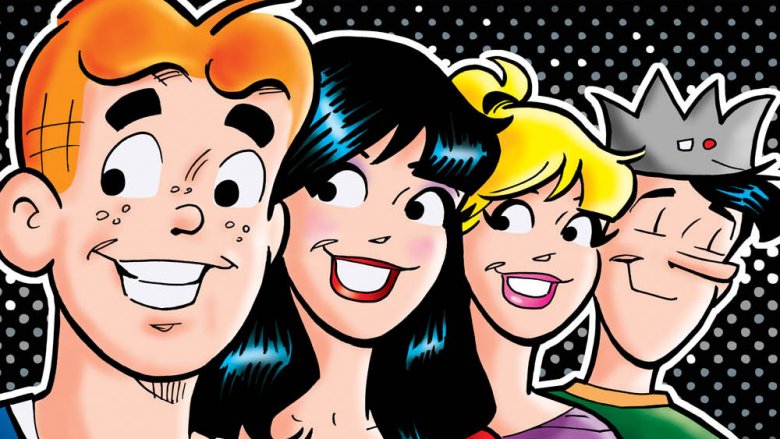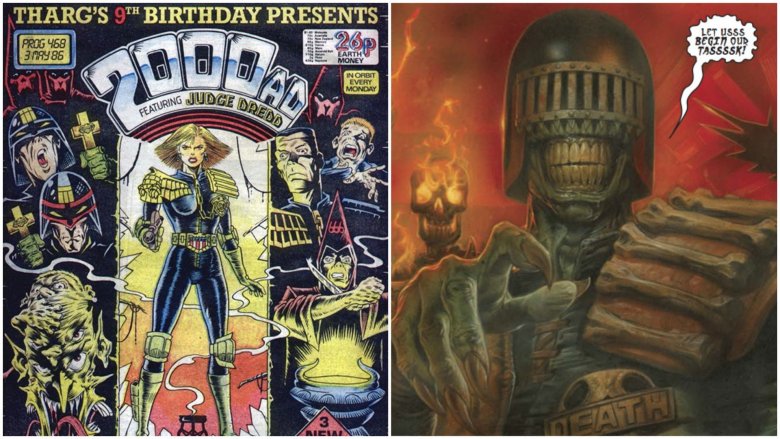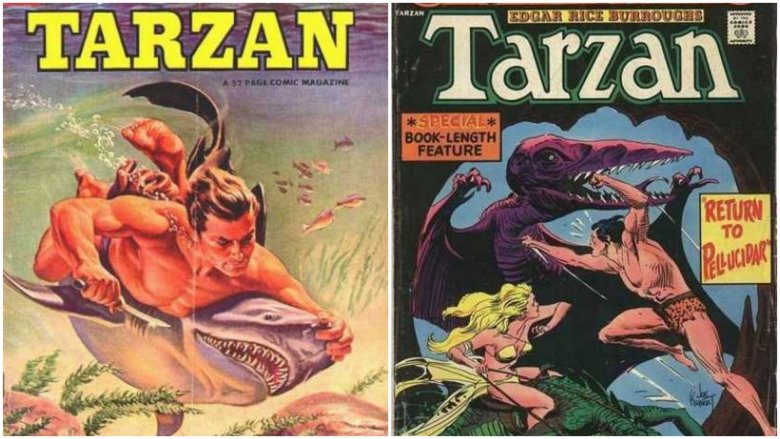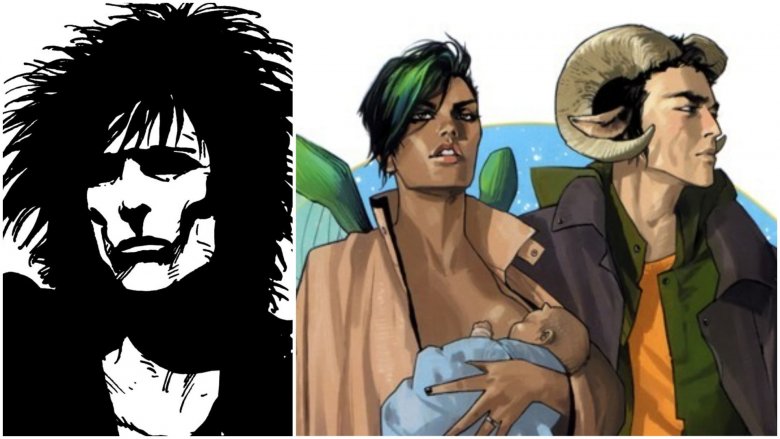Comic Universes That Would Blow The MCU Away
The MCU has grown into such a huge blockbuster juggernaut that it can feel cumbersome for beginners—and even a little nonsensical at times for fans. Arguments can be made for (and against) adapting just about any successful comic under the sun into a series with an MCU-style interconnected universe, but obviously, not all of them are created equal. Here's our list of contenders for comics that, in the right creative hands and with enough funding, could form the basis for great cinematic universes—and maybe even dethrone the MCU.
The Best Arcs from New 52 and DC Rebirth
Up to this point, the DC Extended Universe has tried beating Marvel at its own game by bringing classic characters to the big screen. But what if the publisher dipped into its New 52 and Rebirth initiatives?
Critics' lists of the best New 52 moments vary considerably. As Lan Pitts of Newsarama argued, Jeff Lemire's run on the New 52's update of Animal Man "delivered a perfect blend of family drama, superhero action and horror, with comedic elements sprinkled in for good measure, [as] Buddy tackled threats ranging from Hollywood burnout to the threat of the zombie-esque Rot." No stranger to Grant Morrison's weirdo superhero, having taken over for Morrison on the original series, Lemire knew exactly what he was doing.
Donnie Lederer of Nerdist lauds 2012's Suicide Squad: Kicked in the Teeth for its "excellent banter" and fresh, disturbing take on the "super-villains, sent by the government, run suicide missions to earn a reduced sentence" trope. Suicide Squad (2016) made enough money that a reboot based on Kicked in the Teeth isn't an impossible dream.
As Kieran Shiach asserted in a May 2017 article for Comic Book Resources, the supervillains of the DC Rebirth initiative "have been given a major upgrade." Shiach points out that there is no "Joker or Lex Luthor" nemesis equivalent in Wonder Woman, despite the character's longstanding appeal. For the DC Rebirth version, Greg Rucka added a "wide bench of villains of all stripes, including Veronica Cale, the Cheetah, Circe, Doctor Poison and Doctor Cyber," in the hope of remedying the situation. It's working. Now if we can just get movie execs to understand why the Cheetah would be an awesome supervillain on the big screen...
Wildstorm's The Authority
Wildstorm could make cinematic magic out of Warren Ellis and Bryan Hitch's 12-issue, three-arc run on The Authority, the magnificent, satirical spinoff of Stormwatch. (The 2017 Ellis-scripted reboot isn't bad either, but nothing beats the 1999 original.) Artist Bryan Hitch experimented with the "widescreen" visual style of wanton destruction that he would later bring to Marvel's The Ultimates, the spiritual predecessor to the MCU's over-the-top style.
It's a rare superhero who speaks candidly about making personal sacrifices. "My whole life. I traded it for this one," says the Engineer. She's made sacrifices to "fight people." She misses "being in a lab, being a physicist, a technologist... I don't drink gin and bitter lemon until I fall over. I don't have sex with my ex-boyfriend every third Thursday [anymore]," she says with a bittersweet smirk. Asked why she does what she does, she gives an unpretentious answer. "Because someone needs to."
Before the real-world horrors of September 11, 2001 made narratives about superheroes versus terrorism a dime a dozen, The Authority asked tough questions about the superhero fantasy. At the end of the first story arc, as the victorious Authority members survey the damage, the Engineer all too nonchalantly brings up a question that the MCU rarely asks, Captain America: Civil War notwithstanding: "How many people do you think we killed?" If The Authority were to be adapted with that conversation intact, then MCU critic Mel Gibson couldn't call superhero movies "violence without conscience" anymore. He'd have to find a better excuse for passing on that Odin role.
Injustice and Injustice 2
Out of all the DC properties with MCU-smashing potential, the Injustice comics might rank at the top of the list. In 2016, James Whitbrook of io9 declared Injustice to be "the best evil Superman comic of all time." It's incredible just how engrossing this video game spinoff is; somehow, the tie-in comics have even more depth than the critically acclaimed games on which they're based. The cure for the hangover from Batman v Superman: Dawn of Justice is an Injustice movie.
For starters, panel-for-panel adaptations of Tom Taylor's Injustice Years One and Two would be easy on the screenwriters. Year One (link contains spoilers) gave us Superman and the Flash playing chess together, Superman outing Bruce Wayne as Batman on Twitter, and super pill-popping Alfred—still in his butler outfit—punching Superman's face to a pulp. Year Two gave us one epic Batman speech, a poignant exchange between Batwoman and Renee Montoya, and a fight in which a super-pill powered Commissioner Gordon takes down Cyborg and gets his best line this side of The Killing Joke.
Brian Buccellato's work on Years Three, Four, and Five has its share of fantastic moments too. And how about Chris Sebela's acclaimed Injustice: Ground Zero, with its frightening depiction of Joker and Harley Quinn's abusive relationship or Tom Taylor's triumphant April 2017 return to the franchise, Injustice 2? Like the games, the comics are awesome. The movies could be too.
The Jodoverse of Alejandro Jodorowsky's comics
In the beginning—1978, to be precise—Alejandro Jodorowsky collaborated with the great Jean "Moebius" Giraud on a short called "The Eyes of the Cat" for Metal Hurlant, French precursor to Heavy Metal. Minimalistic and creepy as all get out, it told of a large bird flying over an otherworldly landscape to fetch the titular eyes for a man in a high tower. The first masterpiece of the Jodoverse is The Incal (1981), again with art by Moebius. Later expansions of the Jodoverse include, but are not limited to, Before the Incal (1988) with art by Zoran Janjetov, Final Incal (2008) with art by Jose Ladrönn, and Incal spinoffs such as The Metabarons (1992-2003) with art by Juan Gimenez and The Technopriests (1998) with art by Zoran Janjetov and Fred Beltran.
The Jodoverse is Jodorowsky's vast science fiction universe populated by strange monsters, superpowered goddesslike beings, frightening alien fascists, trash-dwelling Garbage Eaters, creepy Technopriests, psychospiritual warriors, and the mystical crystals known as the Light Incal and the Black Incal, which function in the same god-making way as the Infinity Stones, bestowing godlike powers on their possessors.
The Jodoverse has more than enough compelling content to challenge the MCU; it's as full of reality-smashing power as Jim Starlin's Thanos Quest and The Infinity Gauntlet. And considering the many movies that have lifted content from Jodorowsky's ideas over the years, bringing his comics finally, officially to life would deliver a measure of overdue justice.
Akira (the 1982-1990 manga, not the anime)
According to Cinefix's What's the Difference?, Katsuhiro Otomo hadn't yet finished the manga Akira when he started work on its anime adaptation. Otomo and co-writer Izo Hashimoto struggled to work out the anime's ending until, according to legend, a conversation with Alejandro Jodorowsky inspired Otomo to write the metaphysical final battle between psychic warriors Tetsuo Shima and Shotaro Kaneda.
A big budget live-action Akira series could demolish the MCU. But don't take our word for it. Check out the amazing fan-made trailer above for a glimpse of what this 2,000-page manga masterpiece has in store. And if that doesn't convince you that the MCU's days on top are numbered, maybe the long-rumored live-action Akira will.
The Invisibles
Illustrated by a variety of talented artists including Phil Jimenez, Jill Thompson, Chris Weston, Tommy Lee Edwards, John Ridgway, and Morrison's longtime collaborator Frank Quitely (New X-Men, Batman & Robin, All-Star Superman), Grant Morrison's The Invisibles is a fit of dizzying genius.
In 1994, five years before The Matrix, The Invisibles' King Mob and Lord Fanny did mind-expanding fisticuffs in leather and vinyl gear better than Morpheus, Neo, and Trinity ever would. As Morrison explained in 2009, "When The Matrix came out, it was covering a lot of similar areas. There were bald guys in fetish amounts doing kung-fu." If it's so similar to a movie everybody has already seen, why does the world need an Invisibles movie, let alone an interconnected cinematic universe?
Buzzing with allusions to the Tarot, shamanism, visionary trances, rock-n-roll, transcendental meditation, tantra, New Agey pseudo-philosophy, and reality-bending mind-fights, The Invisibles is more than just a wacky action series. Morrison's inspirations ranged from the traditional to the flat-out bonkers. Like Akira and other psychedelic sci-fi masterpieces, it owes an indirect artistic debt to Jodorowsky and Moebius, and has direct connections to everything from the poetry of Percy Shelley and Lord Byron to the Marquis de Sade and Robert Anton Wilson's Quantum Psychology. Morrison once suggested that if The Invisibles never made it onto the big screen, then perhaps we'd "see it as a video game." Why not both?
Archie
Following the January 2017 premiere of the live-action Riverdale series, critics quickly started speculating about spinoff potential—an appropriate conversation to have, considering the wealth of untapped potential in the brand. Josie and the Pussycats, Betty and Veronica, Jughead and Riverdale get the press, but there are tons of Archie-related franchises.
Archie Horror remains a potential goldmine for horror movie fodder. Archie Sonic's run was epic, even if sales weren't. The Archie vs. Predator series by Alex de Campi (Smoke, No Mercy) could be an AVP-style franchise in and of itself. On account of its long run and friendliness towards crossovers, Archie's town of Riverdale could be comics' equivalent to The Lego Batman Movie's Gotham, only bigger—with superheroes and long-forgotten movie monsters. Indeed, the appeal of Archie is, in part, just how haunted it is by the ghosts of IPs that it has inexplicably survived. If Hollywood can get ahold of the same creators that have kept Archie alive in the face of change, then there's hope for a massive interconnected live-action universe one day.
2000 AD
Featuring gritty characters like everyone's favorite stone-cold fascist Judge Dredd, professional Aeroball player-turned-murderous cyborg Artie Gruber, and lorry-driving vigilante Bill Savage, 2000 AD was, in the words of Garth Ennis, "the greatest comic ever... A glance at the roster of talent involved is enough to take the breath away." That's coming from the creator of Preacher and The Boys.
Tharg the Mighty, 2000 AD's fictional editor who happens to be a leather jacket-clad space alien, frames the anthologized stories in a science fiction meta-narrative. Imagine a movie that jumps in and out of the "real world," with Tharg sending 2000 AD comics to us "Earthlets" from his home planet of Quaxxon, and the awesome events happening in those comics.
Here's the pitch: NeverEnding Story meets Logan by way of Dredd. In the reality-shattering climax, Judge Dredd, Bill Savage, Johnny Alpha and Durham Red from Strontium Dog, Nikolai Dante, Zenith and many more cross into one universe and forming a superhero team, not unlike the Avengers or the Authority, to fight an unholy alliance between Judge Death and the Volgan Republic. Now that's how you rival the MCU.
Tarzan
Edgar Rice Burroughs' eighth Tarzan book, Tarzan the Terrible (1921) introduced Pal-ul-don, a lost civilization crawling with enormous three-horned lizards called Gryfs and humans with tails, into Tarzan lore. Eight years before the Ape-Man's first appearance in comics, he was fighting freakin' dinosaurs like a bona fide sci-fi superhero in the novels if not the movies. Sadly, the movies' Tarzan is more proto-George of the Jungle than the proto-Conan the Barbarian of some of the comics, and recent reboots continue to rehash the same tired jungle adventures of a grownup white-skinned Mowgli-wannabe in a loincloth.
Burroughs changed the world of comics when he invented Tarzan, Caucasian king of the distinctly African jungle. ("Tarzan," we're told, means "white skin" in "ape-speak.") Artist Hal Foster adapted Burroughs' 1912 pulp novel Tarzan of the Apes for daily newspaper comics in 1929. The list of artists who have worked on Tarzan comics during its nine-decade run reads like a list of Hall of Famers: Hal Foster, Joe Kubert, John and Sal Buscema, Burne Hogarth, Frank Frazetta, Gil Kane, Neal Adams...
How has Tarzan lasted so long? The comics have changed with the times, toning down the ethnic stereotyping (thankfully), all the while returning time and again to the original sci-fi fantasy jungle world of the novels for inspiration. If a movie were to reflect the versatility of the Tarzan comics in all their glory, telepathic dinosaurs and shark-fights included, and maybe throw in a few Predators for good measure, the franchise would be reborn in the best way.
Many, many more...
Comics such as Neil Gaiman's Sandman (rumored to be "unfilmable"), Brian K. Vaughn's Y: The Last Man (slated for a TV adaptation but still no movie as of May 2017) and Saga with artist Fiona Staples (don't tell us it's "unfilmable," too), and so, so many others demand to be made into epic film franchises. On the manga front, mech warfare epics such as Robotech and Mazinger-Z (the latter of which is getting an adaptation, announced in January 2017), the pirate-treasure hunters show One Piece, and the supernatural period piece Hellsing all have the depth and wealth of content to challenge the MCU's supremacy—potentially. Clearly, comics are a richer medium than Hollywood understood for years. We're just getting started.
